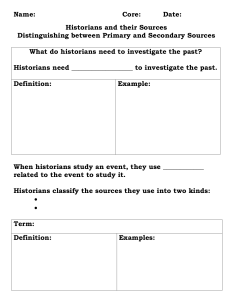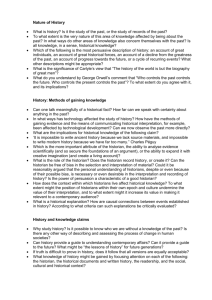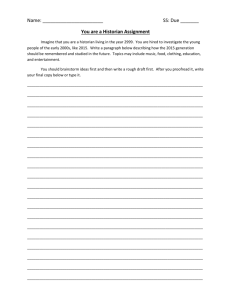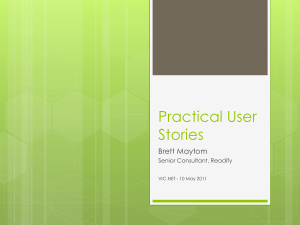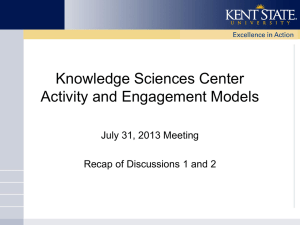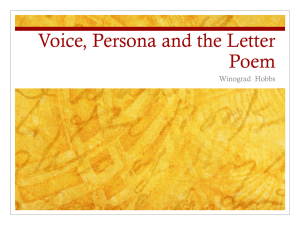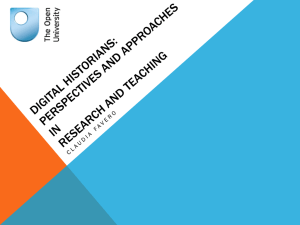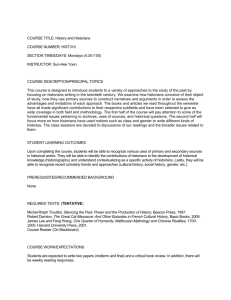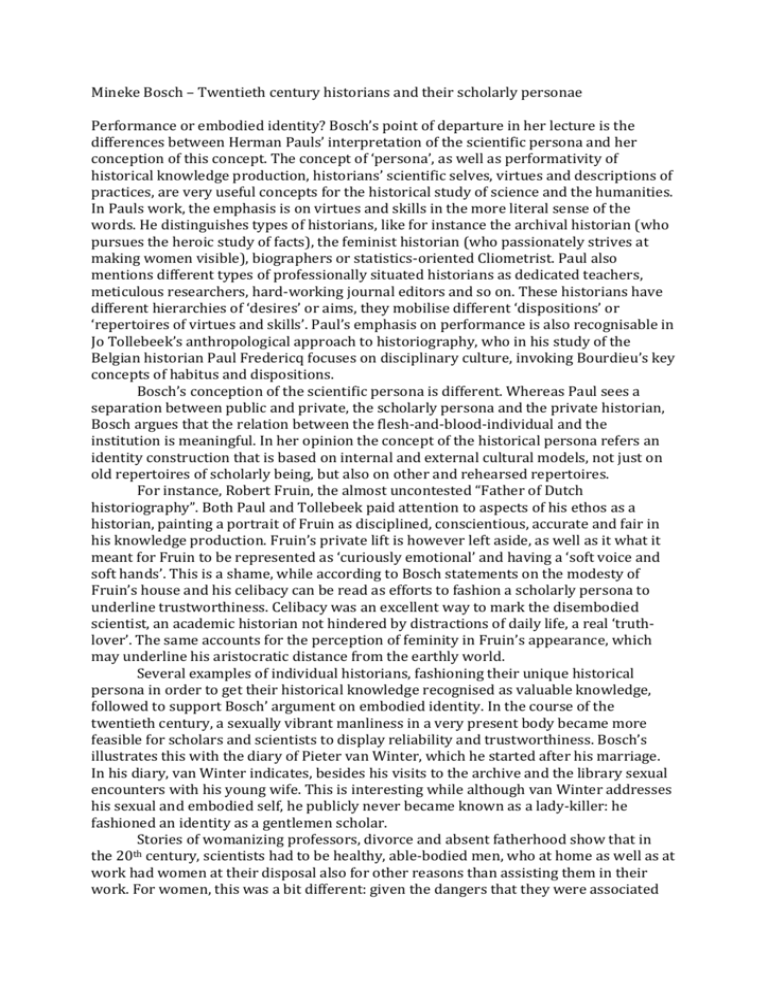
Mineke Bosch – Twentieth century historians and their scholarly personae
Performance or embodied identity? Bosch’s point of departure in her lecture is the
differences between Herman Pauls’ interpretation of the scientific persona and her
conception of this concept. The concept of ‘persona’, as well as performativity of
historical knowledge production, historians’ scientific selves, virtues and descriptions of
practices, are very useful concepts for the historical study of science and the humanities.
In Pauls work, the emphasis is on virtues and skills in the more literal sense of the
words. He distinguishes types of historians, like for instance the archival historian (who
pursues the heroic study of facts), the feminist historian (who passionately strives at
making women visible), biographers or statistics-oriented Cliometrist. Paul also
mentions different types of professionally situated historians as dedicated teachers,
meticulous researchers, hard-working journal editors and so on. These historians have
different hierarchies of ‘desires’ or aims, they mobilise different ‘dispositions’ or
‘repertoires of virtues and skills’. Paul’s emphasis on performance is also recognisable in
Jo Tollebeek’s anthropological approach to historiography, who in his study of the
Belgian historian Paul Fredericq focuses on disciplinary culture, invoking Bourdieu’s key
concepts of habitus and dispositions.
Bosch’s conception of the scientific persona is different. Whereas Paul sees a
separation between public and private, the scholarly persona and the private historian,
Bosch argues that the relation between the flesh-and-blood-individual and the
institution is meaningful. In her opinion the concept of the historical persona refers an
identity construction that is based on internal and external cultural models, not just on
old repertoires of scholarly being, but also on other and rehearsed repertoires.
For instance, Robert Fruin, the almost uncontested “Father of Dutch
historiography”. Both Paul and Tollebeek paid attention to aspects of his ethos as a
historian, painting a portrait of Fruin as disciplined, conscientious, accurate and fair in
his knowledge production. Fruin’s private lift is however left aside, as well as it what it
meant for Fruin to be represented as ‘curiously emotional’ and having a ‘soft voice and
soft hands’. This is a shame, while according to Bosch statements on the modesty of
Fruin’s house and his celibacy can be read as efforts to fashion a scholarly persona to
underline trustworthiness. Celibacy was an excellent way to mark the disembodied
scientist, an academic historian not hindered by distractions of daily life, a real ‘truthlover’. The same accounts for the perception of feminity in Fruin’s appearance, which
may underline his aristocratic distance from the earthly world.
Several examples of individual historians, fashioning their unique historical
persona in order to get their historical knowledge recognised as valuable knowledge,
followed to support Bosch’ argument on embodied identity. In the course of the
twentieth century, a sexually vibrant manliness in a very present body became more
feasible for scholars and scientists to display reliability and trustworthiness. Bosch’s
illustrates this with the diary of Pieter van Winter, which he started after his marriage.
In his diary, van Winter indicates, besides his visits to the archive and the library sexual
encounters with his young wife. This is interesting while although van Winter addresses
his sexual and embodied self, he publicly never became known as a lady-killer: he
fashioned an identity as a gentlemen scholar.
Stories of womanizing professors, divorce and absent fatherhood show that in
th
the 20 century, scientists had to be healthy, able-bodied men, who at home as well as at
work had women at their disposal also for other reasons than assisting them in their
work. For women, this was a bit different: given the dangers that they were associated
with sexuality, many of the women historians who entered the profession since the 20th
century posed themselves as ‘brides of science’ rather than as wives and mothers. For
example Marie Curie cultivated a scientific asceticism, even though she was married and
a mother. Sini Regtdoorzee Greup-Roldanus was married, but made clear that she would
not be blessed by children so that she could keep her teaching position. Others, like
Johanna Naber, remained unmarried, and lived together with siblings or women friends.
Interesting is also the story of Annie Romein, who became famous for the picture she
created for herself as the part-time girl servant, ‘het meisje voor halve dagen’. By
emphasising her “laziness”, she contradicted the stereotype of the industrious rather
than the intelligent and creative woman, so that in the end she poses as a genius and
someone who effortless reached success.
What Bosch wanted to illustrate with these examples is that the concept of the
historical persona refers to identity construction, based on power and cultural ways of
expressing difference and identity. Therefore, rather than conceiving persona as the
outcome of specific historiographical aims of historians, or the virtues, character traits
and skills they developed to reach these aims, we should consider the conception of
persona as an embodied identity that aims at convincing the audience of the historian’s
reliability and credibility. Moreover, we should take new bodily as well as spiritual
practices and repertoires into account in the discussion about the standards of
behaviour and a possible virtue code for professional historical behaviour.

